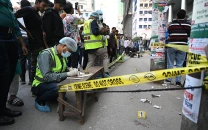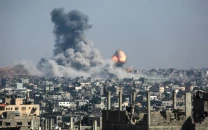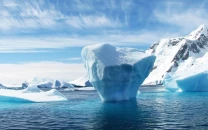Over 300 would-be migrants feared to have drowned in new Mediterranean boat tragedy
nine migrants part of the group, were rescued by the coastguard and taken to the Italian island of Lampedusa

A total 29 Africans believed to have sailed in the same fleet perished from exposure as they tried to reach Italy in rough seas. PHOTO: REUTERS
The victims were mainly from sub-Saharan Africa who had left the coast of Libya at the weekend in four small boats, the UN refugee agency said.
A total 29 Africans believed to have sailed in the same fleet perished from exposure as they tried to reach Italy in rough seas.
"This is a tragedy on an enormous scale and a stark reminder that more lives could be lost if those seeking safety are left at the mercy of the sea," UNHCR Europe director Vincent Cochetel said in a statement.
Details of the apparent mass drownings emerged after nine migrants -- in a group of more than 200 packed into two dinghies -- were rescued by the coastguard and taken to the Italian island of Lampedusa.
"Nine were saved after four days at sea. The other 203 were swallowed by the waves," UNHCR spokesperson in Italy, Carlotta Sami, said on Twitter.
The agency later said reports from survivors in Lampedusa now suggest some 300 people are confirmed missing as a fourth boat is unaccounted for.
International Organization for Migration said it feared the latest death toll could eclipse the shocking toll from a single accident in October 2013 when 366 migrants drowned off Lampedusa in a similar attempt to reach Europe.
"What's happening now is worse than a tragedy -- it's a crime," IOM chief William Lacy Swing said in a statement.
"These smuggling networks act with virtual impunity, hundreds are dying," he said, adding: "The world must act."
Last year, more than 3,200 people died while attempting to reach Italy by boat from North Africa, on what the United Nations has described as the most dangerous route in the world.
IOM warned 2015 could be even deadlier, pointing out that the latest suspected drownings come on top of 115 deaths reported in the Mediterranean since the beginning of the year.
That compares to just 27 deaths during the same period last year, IOM said.
Survivors who spoke with the organisation's staff in Lampedusa on Wednesday described how ruthless smugglers had forced them to board inflatable rafts and set out in raging seas.
"They forced us to climb aboard the ship with guns and sticks, robbing us of all our belongings," one survivor was quoted as saying by IOM.
The 29 who were found Saturday had died of exposure in horrific conditions in international waters, in what humanitarian organisations said was an avoidable tragedy.
Their small boat was hopelessly ill-equipped to cope with waves up to eight metres (25-feet) high, gale-force winds and torrential rain.
But doctors involved in the rescue operation believe more would have survived if they had been rescued by a large military vessel rather than the small patrol boats that were sent to their aid.
The latest deaths have highlighted the limited means and scope of Triton, an EU-run mission which took over in November from the Italian navy's Mare Nostrum search and rescue operation.
Italy decided to scale back the mission after its EU partners refused to share running costs of around nine million euros ($10 million) a month.
Triton, which comes under the authority of the EU borders agency Frontex, has a monthly budget of 2.9 million euros ($3.3 million) and its patrols are generally restricted to the territorial waters of EU member states.
Amnesty International slammed the EU countries Wednesday for "burying their heads in the sand while hundreds keep dying at sea."
"The humanitarian crisis that sparked the need for Mare Nostrum has not gone away," said John Dalhuisen, head of Amnesty's Europe and Central Asia operations.
More than 170,000 people arrived in Italy in 2014 after being picked up by the navy, coastguard or merchant ships.
Most of the migrants are fleeing conflict and repression in the Middle East and east Africa and make their way overland to Libya to board boats operated by people smugglers.



















COMMENTS
Comments are moderated and generally will be posted if they are on-topic and not abusive.
For more information, please see our Comments FAQ